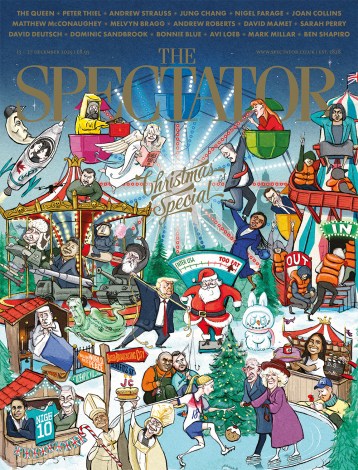One of the joys of getting older is the appreciation of the solitary pint. But what to do as you sip your hard-earned beer? Usually after a suitable period of contemplation I’ll start fiddling with my phone. Not Adrian Tierney-Jones; he writes books, and his latest, A Pub for All Seasons (Headline, £20), is a poetic meditation on the public house, its history and place in our culture with some memoir deftly thrown in. Most of all it’s an appreciation of what makes a pub great: the layers accumulated by decades – centuries, sometimes – of human interaction. ‘The perfect pub,’ he writes, ‘is a kind of metaphysical palimpsest which we should try to imagine as a constantly evolving space.’ This is why it’s so sad when a new landlord comes in, strips away the clutter and replaces it with cushions that say ‘Love’ on them.
It’s nearly impossible to visit the Jura’s winemakers now as they are too busy dealing with orders from Taiwan
It’s from the public bar to the wine bar with Dan Keeling’s Who’s Afraid of Romanée-Conti? (Quadrille, £30). Keeling is one of the cleverest people in the wine trade; with his partner Mark Andrews, he managed to make the previously staid business of selling upmarket wine cool. Their little empire started with a low-circulation magazine called Noble Rot and now encompasses three restaurants, a shop and a wine merchants.
Annoyingly, Keeling writes well too, successfully conveying the often rarefied world of fine wine to the general reader. By the end of the book you really won’t be afraid of Romanée-Conti, should you ever come across a bottle – which is unlikely, as the wines are incredibly rare and expensive. Indeed, most of what Keeling writes about is out of my price range, so I eagerly turned to the section titled ‘You don’t have to be rich to cellar great wine’. Here he suggests spending ‘an initial £750 on 12 bottles’. I have a feeling this book may not be aimed at me.
Nevertheless, I enjoyed it rather in the way that I read classic car magazines as a boy. One of the best chapters is on vin jaune: ‘It was the only time fermented grape juice has made me laugh out loud involuntarily,’ Keeling writes. This sherry-like wine comes from the Jura, a previously obscure area sandwiched between Burgundy and Switzerland which has become madly fashionable. The amusingly named Wink Lorch wrote the definitive book on the region in 2014, but so much has changed since then that she’s followed it up with the aptly titled Jura Wine Ten Years On (Académie du Vin, £15). Jura’s new-found fame means that prices of the best wines have soared; furthermore, it’s nearly impossible to visit the growers now as they’re too busy dealing with orders from Taiwan.
English wine has also been transformed by a sudden influx of money, so it’s interesting to look at the other end of the scale. Christopher Cooke is a former publisher who planted a small vineyard in Berkshire. Anyone who’s thinking of making wine in England should read Ancient Land, Pastures New (Biddles Books, £17.50). It’ll probably put you off, but you’ll have some laughs along the way. Oh, and his fizz, Winding Wood, is well worth seeking out.
Another book that the wine bore in your life won’t want to be without is One Thousand Vines: A New Way to Understand Wine (Mitchell Beazley, £45), an insanely ambitious work by the young French sommelier Pascaline Lepeltier. In it she attempts to cover the history, science, culture and philosophy of wine – like the collected works of Jancis Robinson, Hugh Johnson and Andrew Jefford distilled in one volume. It’s a book that requires focus on the part of the reader; even so, a lot of it went over my head, not least the final chapter which gets a bit woo-woo. Nevertheless, it’s a remarkable achievement.
Somewhat more accessible is On Tuscany (Académie du Vin, £35), a compendium of articles about the wines of Montalcino and Chianti etc. It’s not just a wine book: it also delves into the culture and history of this most rich of Italian regions and includes essays by D.H. Lawrence and Curzio Malaparte. Victoria Moore in particular is on mouth-watering form writing about Tuscan food. What’s fascinating about Tuscany is that there is no unbroken tradition of high quality wines there, as in Burgundy and Bordeaux – so there’s still much to be discovered about Tuscan wine and its great but difficult grape Sangiovese, which means ‘blood of Jupiter’.
From Jupiter to juniper: as any fule kno, gin was invented by the Dutch and popularised in England when William of Orange became king in 1688. Not so fast, say the husband and wife duo Jared Brown and Anistatia Miller in A Most Noble Water: Revisiting the Origins of English Gin (Mixellany, £14.95), which is surely destined to become a classic. He’s a master distiller, the founder of Sipsmith, and she’s an academic historian. What they have discovered from primary sources should rock the drinks world to its foundations. Apparently gin almost certainly came from Germany: a recipe for it was translated into English from German in 1527. The book shows how juniper-flavoured spirits were being enjoyed in the reigns of Henry VIII and Elizabeth I, long before the Glorious Revolution. Furthermore, the authors have uncovered an English recipe from 1639, combining juniper, citrus and spice, which Sipsmith is going to put into production.
Which brings us to the greatest of all gin drinks, the gin and tonic… sorry, the dry martini. Step forward Alice Lascelles. Her previous book, The Cocktail Edit, was a strong candidate for the only cocktail book you’ll ever need; but you should now make space for The Martini: The Ultimate Guide to a Cocktail Icon (Quadrille, £8.99). It’s a marvellous combination of history and recipe book that will have you reaching for your shaker as soon as 6 o’clock comes round.
But it’s a bit early for a martini. Maybe I can get a quick pint in before I pick up our youngest from school.







Comments